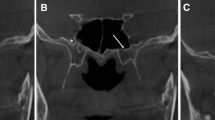Abstract
Purpose
To delineate the pterygoid canal (PC) configuration and its position in relation to surrounding important anatomical landmarks using three-dimensional reconstructive technology based on CT for the Chinese.
Methods
The computerized tomography arteriography (CTA) data of 137 patients were retrospectively evaluated using neuroimaging three-dimensional reconstructive software. The morphological parameters of the PC as well as the spatial relationship and distance between the PC relative to internal carotid artery (ICA) and the foramen rotundum were evaluated.
Results
83.9 % of the PC can be identified by our neuroimaging three-dimensional reconstructive software. The mean distance from the PC to the ICA was 2.6 ± 1.2 mm. The mean distance between medial aspects of bilateral ICA was 19.6 ± 2.7 mm. The distal vertical and horizontal distances between the PC and foramen rotundum were 5.2 ± 3.2 and 6.1 ± 2.8 mm, respectively. All the proximal end of the PC were inferior-lateral to the ICA. The PC mainly (92.9 %) ran posteriorly with a medial to lateral direction. The distance from the PC to ICA was positively correlated with the distance between bilateral ICA and the distal diameter of the PC. The vertical distance between the PC and foramen rotundum was positively correlated with the length of the PC and the horizontal distance between the PC and foramen rotundum.
Conclusions
Understanding the configuration and spatial relationship of the PC may be helpful to improve the accuracy and safety of operation during the expanded transnasal endoscopic approaches to skull base. The three-dimensional reconstructive virtual anatomic technology may be a useful tool to delineate the PC configuration and its position to surrounding important anatomical landmarks.






Similar content being viewed by others
References
Hwang SH, Joo YH, Seo JH, Kim SW, Cho JH, Kang JM (2011) Three-dimensional computed tomography analysis to help define an endoscopic endonasal approach of the pterygopalatine fossa. Am J Rhinol Allergy 25:346–350
Kassam AB, Gardner P, Snyderman C, Mintz A, Carrau R (2005) Expanded endonasal approach: fully endoscopic, completely transnasal approach to the middle third of the clivus, petrous bone, middle cranial fossa, and infratemporal fossa. Neurosurg Focus 19:E6
Kassam AB, Vescan AD, Carrau RL et al (2008) Expanded endonasal approach: vidian canal as a landmark to the petrous internal carotid artery. J Neurosurg 108:177–183
Kim HS, Kim DI, Chung IH (1996) High-resolution CT of the pterygopalatine fossa and its communications. Neuroradiology 38:120–1265
Lazaridis N, Natsis K, Koebke J, Themelis C (2010) Nasal, sellar, and sphenoid sinus measurements in relation to pituitary surgery. Clin Anat 23:629–636
Liu SC, Wang HW, Su WF (2010) Endoscopic vidian neurectomy: the value of preoperative computed tomographic guidance. Arch Otolaryngol Head Neck Surg 136:595–602
Omami G, Hewaidi G, Mathew R (2011) The neglected anatomical and clinical aspects of pterygoid canal: CT scan study. Surg Radiol Anat 33:697–702
Osawa S, Rhoton AJ, Seker A, Shimizu S, Fujii K, Kassam AB (2009) Microsurgical and endoscopic anatomy of the vidian canal. Neurosurgery 64:385–411
Pinheiro-Neto CD, Fernandez-Miranda JC, Rivera-Serrano CM et al (2012) Endoscopic anatomy of the palatovaginal canal (palatosphenoidal canal): a landmark for dissection of the vidian nerve during endonasal transpterygoid approaches. Laryngoscope 122:6–12
Rosahl SK, Gharabaghi A, Hubbe U, Shahidi R, Samii M (2006) Virtual reality augmentation in skull base surgery. Skull Base 16:59–66
Snyderman CH, Pant H, Carrau RL, Prevedello D, Gardner P, Kassam AB (2009) What are the limits of endoscopic sinus surgery?: the expanded endonasal approach to the skull base. Keio J Med 58:152–160
Tubbs RS, Salter EG (2006) Vidius Vidius (Guido Guidi): 1509–1569. Neurosurgery 59:201–203
Unal B, Bademci G, Bilgili YK, Batay F, Avci E (2006) Risky anatomic variations of sphenoid sinus for surgery. Surg Radiol Anat 28:195–201
Vescan AD, Snyderman CH, Carrau RL et al (2007) Vidian canal: analysis and relationship to the internal carotid artery. Laryngoscope 117:1338–1342
Wang SS, Xue L, Jing JJ, Wang RM (2011) Virtual reality surgical anatomy of the sphenoid sinus and adjacent structures by the transnasal approach. J Craniomaxillofac Surg 40:494–499
Yazar F, Haholu A, Cankal F, Kilic C, Tekdemir I (2007) CT evaluation of the vidian canal localization. Clin Anat 20:751–754
Zinreich SJ (1998) Functional anatomy and computed tomography imaging of the paranasal sinuses. Am J Med Sci 316:2–12
Acknowledgments
This study was supported by the National Natural Science Foundation of China (No. 81271314), Natural Science Foundation of Guangdong (No. 5300468), and Special Project on the Integration of Industry, Education and Research of Guangdong Province and Ministry of Education (No. 2012B091100154).
Conflict of interest
The authors declare that they have no conflict of interest.
Author information
Authors and Affiliations
Corresponding author
Rights and permissions
About this article
Cite this article
Fu, Z., Chen, Y., Jiang, W. et al. The anatomical and clinical details of the pterygoid canal: a three-dimensional reconstructive virtual anatomic evaluation based on CT. Surg Radiol Anat 36, 181–188 (2014). https://doi.org/10.1007/s00276-013-1161-x
Received:
Accepted:
Published:
Issue Date:
DOI: https://doi.org/10.1007/s00276-013-1161-x




